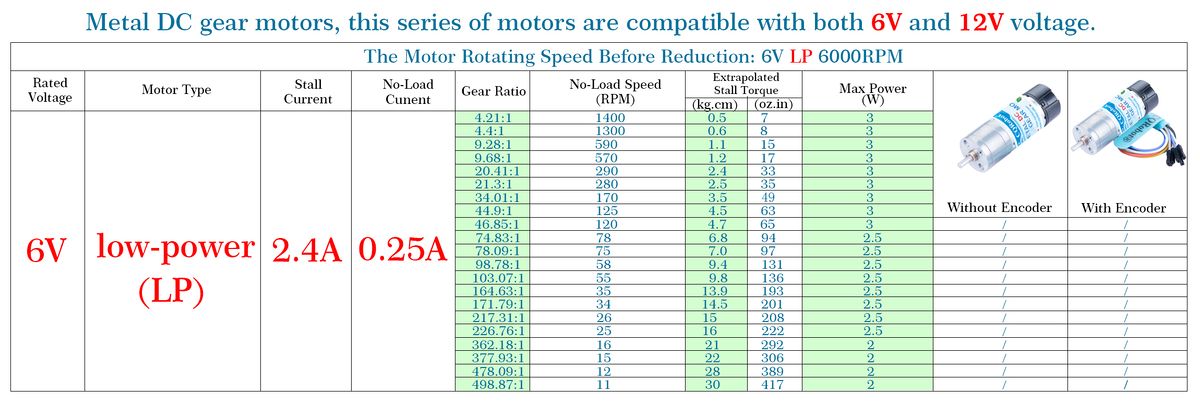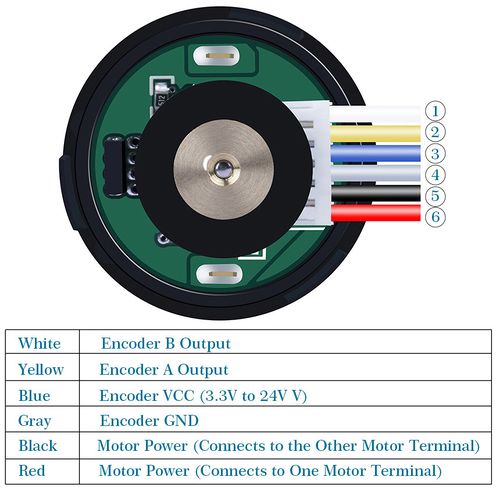DC Gearmotor SKU: CQR25D
Contents
Description
These cylindrical brushed DC gearmotors are available in a wide range of gear ratios and with five different motors (two power levels of 6V motors and three power levels of 12V motors). The gearmotors all have the same 25 mm diameter body and 4 mm diameter gearbox output shaft, so it is generally easy to swap one version for another if your design requirements change (though the length of the gearbox tends to increase with the gear ratio). All versions are also available with an integrated 48 CPR quadrature encoder on the motor shaft.
LP, MP, HP Specifications
There are ten series of specifications for metal DC gear motors:
- The first specification: low power 6V voltage metal DC gear reducer motor;
- The second specification: high-power 6V voltage metal DC gear reducer motor;
- The third specification: low-power 12V voltage metal DC gear reducer motor;
- The fourth specification: medium power 12V voltage metal DC gear reducer motor;
- The fifth specification: high-power 12V voltage metal DC gear reducer motor;
- The sixth specification: low power 6V voltage metal DC gear reducer motor with encoder;
- The seventh specification: high-power 6V voltage metal DC gear reducer motor with encoder;
- The eighth specification: low power 12V voltage metal DC gear reducer motor with encoder;
- The ninth specification: medium power 12V voltage metal DC gear reducer motor with encoder;
- The tenth specification: high-power 12V voltage metal DC gear reducer motor with encoder.
Special Attention: Stalling or overloading gearmotors can greatly decrease their lifetimes and even result in immediate damage. For these gearboxes, the recommended upper limit for instantaneous torque is 30 kg-cm (400 oz-in); we strongly advise keeping applied loads well under this limit. Stalls can also result in rapid (potentially on the order of a second) thermal damage to the motor windings and brushes, especially for the versions that use high-power (HP) motors; a general recommendation for brushed DC motor operation is 25% or less of the stall current.
Gearmotors Appearance
In general, these kinds of motors can run at voltages above and below their nominal voltages (they can begin rotating at voltages as low as 1 V); lower voltages might not be practical, and higher voltages could start negatively affecting the life of the motor.
Size and Display
Warning: Do not screw too far into the mounting holes as the screws can hit the gears. We recommend screwing no further than 6 mm (0.24″) into the screw hole.
Custom Made
- Quantity: Starting from 500 pieces;
- Cable Specifications: Please provide connector terminal specification documentation;
- Motor Output Shaft (SHAFT): within 100 mm.
Using the Encoder
A two-channel Hall effect encoder is used to sense the rotation of a magnetic disk on a rear protrusion of the motor shaft. The quadrature encoder provides a resolution of 48 counts per revolution of the motor shaft when counting both edges of both channels. To compute the counts per revolution of the gearbox output, multiply the gear ratio by 48.
The motor/encoder has six color-coded, 8″ (20 cm) leads terminated by a 1×6 female header with a 0.1″ pitch, as shown in the main product picture. This header works with standard 0.1″ male headers and our male jumper and precrimped wires. If this header is not convenient for your application, you can pull the crimped wires out of the header or cut the header off. The following table describes the wire functions:
The Hall sensor requires an input voltage, Vcc, between 3.3 and 24 V and draws a maximum of 10 mA. The A and B outputs are square waves from 0 V to Vcc approximately 90° out of phase. The frequency of the transitions tells you the speed of the motor, and the order of the transitions tells you the direction. The following oscilloscope capture shows the A and B (yellow and white) encoder outputs using a motor voltage of 6 V and a Hall sensor Vcc of 5 V:
By counting both the rising and falling edges of both the A and B outputs, it is possible to get 48 counts per revolution of the motor shaft. Using just a single edge of one channel results in 12 counts per revolution of the motor shaft, so the frequency of the A output in the above oscilloscope capture is 12 times the motor rotation frequency.














